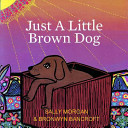Sally Morgan's dedication 'To our animal brothers and sisters who give us comfort' highlights the first layer of meaning in this story, which is about the way friendship and a loving heart can help to heal grief and loneliness. The Little Brown Dog is the runt of the litter, and partly because he is overlooked, he is free to express his feelings: such as rolling in a dark spot in the garden, where everything is rotting and smells - to him 'wonderful' - but to everyone else disgusting. Mr Smith gives him a bath, but the visitors who come to buy his whole litter of pups drive off and leave the little brown dog behind. He has lost his mother, and now he has lost all his brothers and sisters. At night the little brown dog is afraid and crawls right inside the pungent garden smell for comfort - and of course in the morning Mr Smith needs to wash him again. When he takes the little brown dog to the pet shop, the owner's son Tom is feeling acutely the loss of his own mother, but when he sees the little brown dog, he knows that he has found a new friend. He gives him a name, Butch, and they go everywhere together.
The emphasis on the puppy's smallness and his feeling of being excluded - by his brothers and sisters, by the smell he acquires from doing what he loves best, by his not being purebred, by the visitors who purchase every pup but him, and by the loss of his mother - all elements outside his control, invite young readers to deeper understandings of the narrative. The words 'JUST A' in the title echo the generally dismissive attitude the Little Brown Dog has experienced.
In other hands this story might not have invited a reading about race. But in the skilled hands of two high-profile Indigenous creators, Sally Morgan (a Palku author) and Bronwyn Bancroft (a Bunjalung artist), all features of the puppy's story point to a very personal understanding of how it feels to lose your family and friends and to be marginalised. Older readers may make connections with the Stolen Generation, with life on the missions or reserves. Readers interested in metanarratives may be drawn to the roles played by animals in picture books, fiction, film and in art generally. Readers interested in human grief - and indeed in the grief of non-human animals - may be interested in various kinds of therapy involving animals. None of these layers of meaning is inevitable, though, because in general 'Just a Little Brown Dog' steps carefully around didacticism.
Bronwyn Bancroft's visual style makes an important contribution. Its saturated colour palette, its black pokerwork outlines, its diverse textures and iconography make clear reference to contemporary Indigenous Australian art. But the exuberant use of flowers and plants refers to mid-century hippie 'Flower Power', and the black character silhouettes intersect with picture books from other traditions, such as Latinx and African-American cultures. So this story of difference and exclusion has both culture-specific and fluid frames of reference.

